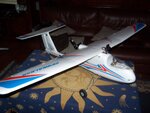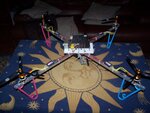lothar2048
New member
Some little questions regarding simple improvements for Realflight G5.
Most of FPV users are greatly satisfied with this version which is now offering such capabilities. But some things are greatly missing for us, and most of us are using some OSD to fly away, different configurations and so on.
In order to get a valuable solution for FPV users, here is the list of improvement we should be needing to make RFG5 one of the best offer.
- OSD base. A basic one with all needed data show on the screen when camera is switched only. Best offer would be reproducing OSD's actual screens and options like Eagletree, Remzibi, Dragon OSD, Feyun Tech and Easy OSD clones...
- Ground Station capabilities, with OSD interracting like autopilot, autonomous flight, waypointing, realtime flight map and such improvements. The idea is to be able to view model camera, or switch to different screens. There are only few offers on the market, but EagleTree, Dragon OSD and Feyun Tech are offering such capabilities with google mapping.
- Range problems and Image alterations when flying. Adding such capabilities would be great. When the model would be over range, the failsafe function or autopilot could be taking care of model return to home functions. Based on already done job with Nexstar, the stabilisation system won't be a big deal ? Image could be altered due to over range or when passing behind an object.
Some general improvements :
When flying an helicopter and adding pitch, the smashplate is also crossing from side to side, which is no a real model behaviour. Most of radio gears are correcting such effect and no need to trim it constantly to get a proper hovering at any altitude or power input. So why 3D users are not using G5 but other solutions...
When flying planes, and like the Easystar which has a zero pitch underwing, the model is not supposed to climb or descend with different throtteling when he is reaching the appropriate speed. This is a very old style method, and most of modern models don't react anymore like this in reality. This was happening before as the motor or engines were not offering enough power (less than 1.0 weight to power ratio). New engines and motors are now offering over 1.0 ratio, so it is now an option to take it in consideration, and mostly for fixed wings with zero pitch undersurface would thank you ;-).
I don't know where you are buying your batteries, but you should be considering their overestimated lifetime. The same for power engines and fuel consumption. A slider button for battery quality or fuel consumption rate for any model could be a usefull simple improvement.
Two specific maps would also be great :
- One for FPV users with two airports and different waypointings (Auto circle, circuits, airport to airport, etc.).
- One for Airplane and helicopter users with obstacles. This is done in asia, and there are many competitions for slow fliers and hellicopter users thought specific flying circuits. This is a very good training improvement when obstacles are very straight and dedicated to a plane or helicopter size.
I also noticed this was a terrific problem to switch between HH and normal mode for helicopter users. Most of scale models are using classical curving for the rudder, and they are alway set to Heading Hold, which is an awfull crime i think. As the procedure is quite difficult to change this, i'm not flying scale helicopters anymore.
This would be great to switch back your mind and use the 3 states button to offer :
- State One, Normal Mode 50%.
- State Two, HH 50%
- State Tree, HH 65%.
Bug tracking : In french language, when you are trying to use accentuated caracters in model edition, you are getting an error when trying to save it with accentuated caracters. But when you are switching to this language from default english, this is already offered by the application. You should be correcting this bug...
ASL altitude is not showing the correct altitude in many maps. As this is a sea level reference, this is the absolute altutide i think ? but when you are trying with sea mapps, altitude is not correctly set as well. So i think, you have a problem with this. How can we set it to Zero when flying in FPV mode ?
Also, any model have an on top max altitude. Can you manage to add this parameter for further improvements ?
So please, let us know what you think. Any comments are welcome.
Kind Regards.
Francois.
Most of FPV users are greatly satisfied with this version which is now offering such capabilities. But some things are greatly missing for us, and most of us are using some OSD to fly away, different configurations and so on.
In order to get a valuable solution for FPV users, here is the list of improvement we should be needing to make RFG5 one of the best offer.
- OSD base. A basic one with all needed data show on the screen when camera is switched only. Best offer would be reproducing OSD's actual screens and options like Eagletree, Remzibi, Dragon OSD, Feyun Tech and Easy OSD clones...
- Ground Station capabilities, with OSD interracting like autopilot, autonomous flight, waypointing, realtime flight map and such improvements. The idea is to be able to view model camera, or switch to different screens. There are only few offers on the market, but EagleTree, Dragon OSD and Feyun Tech are offering such capabilities with google mapping.
- Range problems and Image alterations when flying. Adding such capabilities would be great. When the model would be over range, the failsafe function or autopilot could be taking care of model return to home functions. Based on already done job with Nexstar, the stabilisation system won't be a big deal ? Image could be altered due to over range or when passing behind an object.
Some general improvements :
When flying an helicopter and adding pitch, the smashplate is also crossing from side to side, which is no a real model behaviour. Most of radio gears are correcting such effect and no need to trim it constantly to get a proper hovering at any altitude or power input. So why 3D users are not using G5 but other solutions...
When flying planes, and like the Easystar which has a zero pitch underwing, the model is not supposed to climb or descend with different throtteling when he is reaching the appropriate speed. This is a very old style method, and most of modern models don't react anymore like this in reality. This was happening before as the motor or engines were not offering enough power (less than 1.0 weight to power ratio). New engines and motors are now offering over 1.0 ratio, so it is now an option to take it in consideration, and mostly for fixed wings with zero pitch undersurface would thank you ;-).
I don't know where you are buying your batteries, but you should be considering their overestimated lifetime. The same for power engines and fuel consumption. A slider button for battery quality or fuel consumption rate for any model could be a usefull simple improvement.
Two specific maps would also be great :
- One for FPV users with two airports and different waypointings (Auto circle, circuits, airport to airport, etc.).
- One for Airplane and helicopter users with obstacles. This is done in asia, and there are many competitions for slow fliers and hellicopter users thought specific flying circuits. This is a very good training improvement when obstacles are very straight and dedicated to a plane or helicopter size.
I also noticed this was a terrific problem to switch between HH and normal mode for helicopter users. Most of scale models are using classical curving for the rudder, and they are alway set to Heading Hold, which is an awfull crime i think. As the procedure is quite difficult to change this, i'm not flying scale helicopters anymore.
This would be great to switch back your mind and use the 3 states button to offer :
- State One, Normal Mode 50%.
- State Two, HH 50%
- State Tree, HH 65%.
Bug tracking : In french language, when you are trying to use accentuated caracters in model edition, you are getting an error when trying to save it with accentuated caracters. But when you are switching to this language from default english, this is already offered by the application. You should be correcting this bug...
ASL altitude is not showing the correct altitude in many maps. As this is a sea level reference, this is the absolute altutide i think ? but when you are trying with sea mapps, altitude is not correctly set as well. So i think, you have a problem with this. How can we set it to Zero when flying in FPV mode ?
Also, any model have an on top max altitude. Can you manage to add this parameter for further improvements ?
So please, let us know what you think. Any comments are welcome.
Kind Regards.
Francois.




